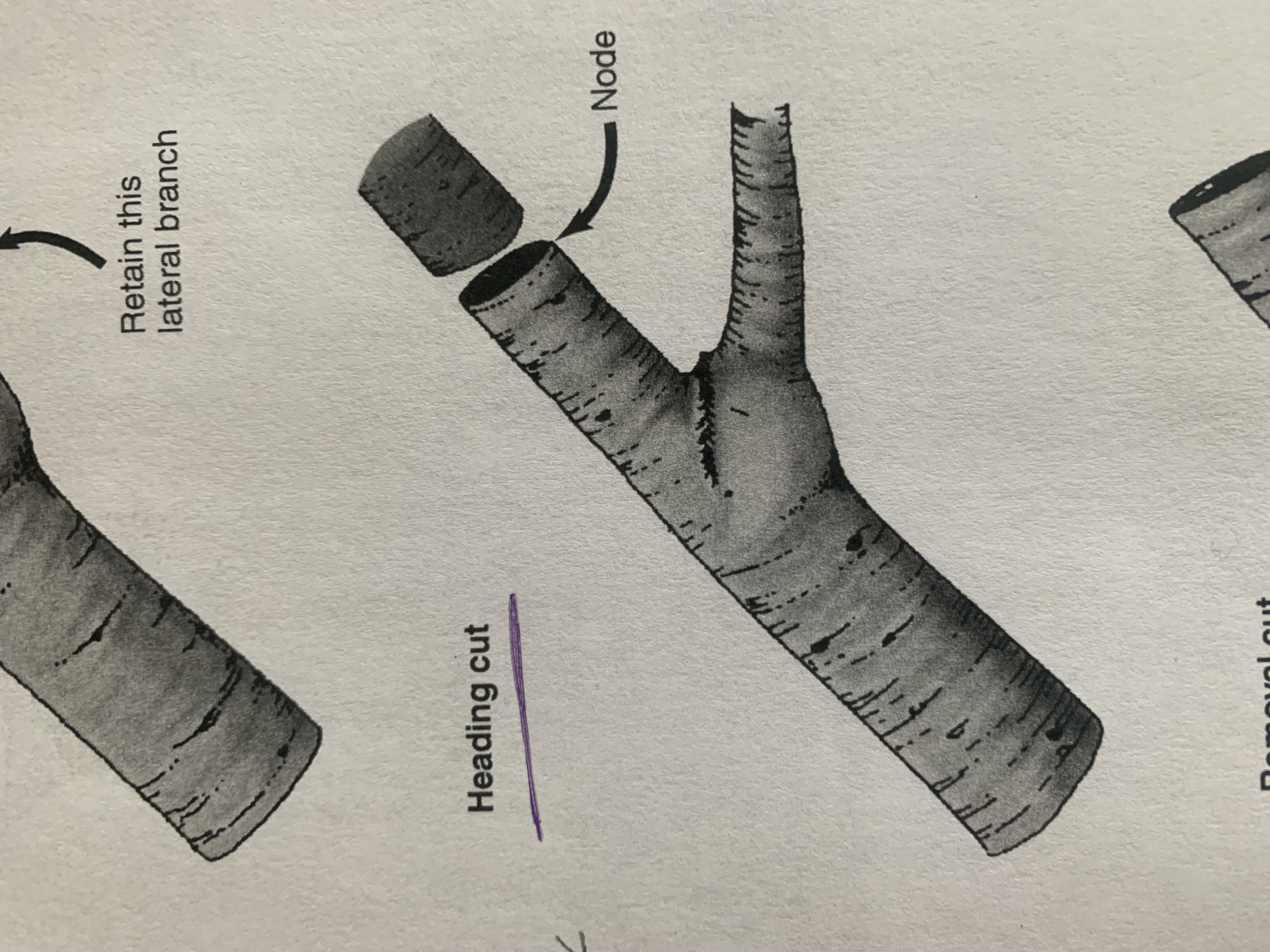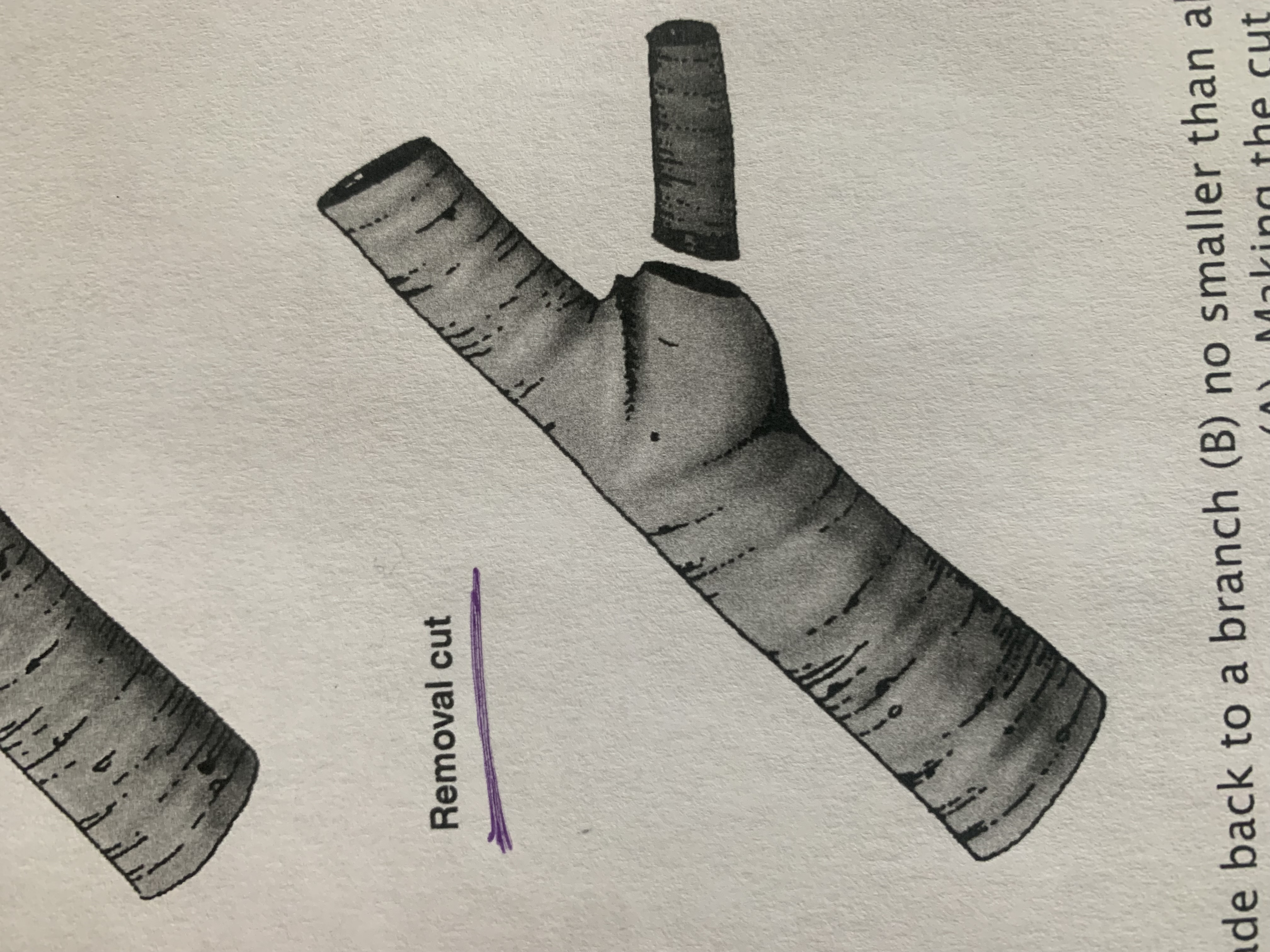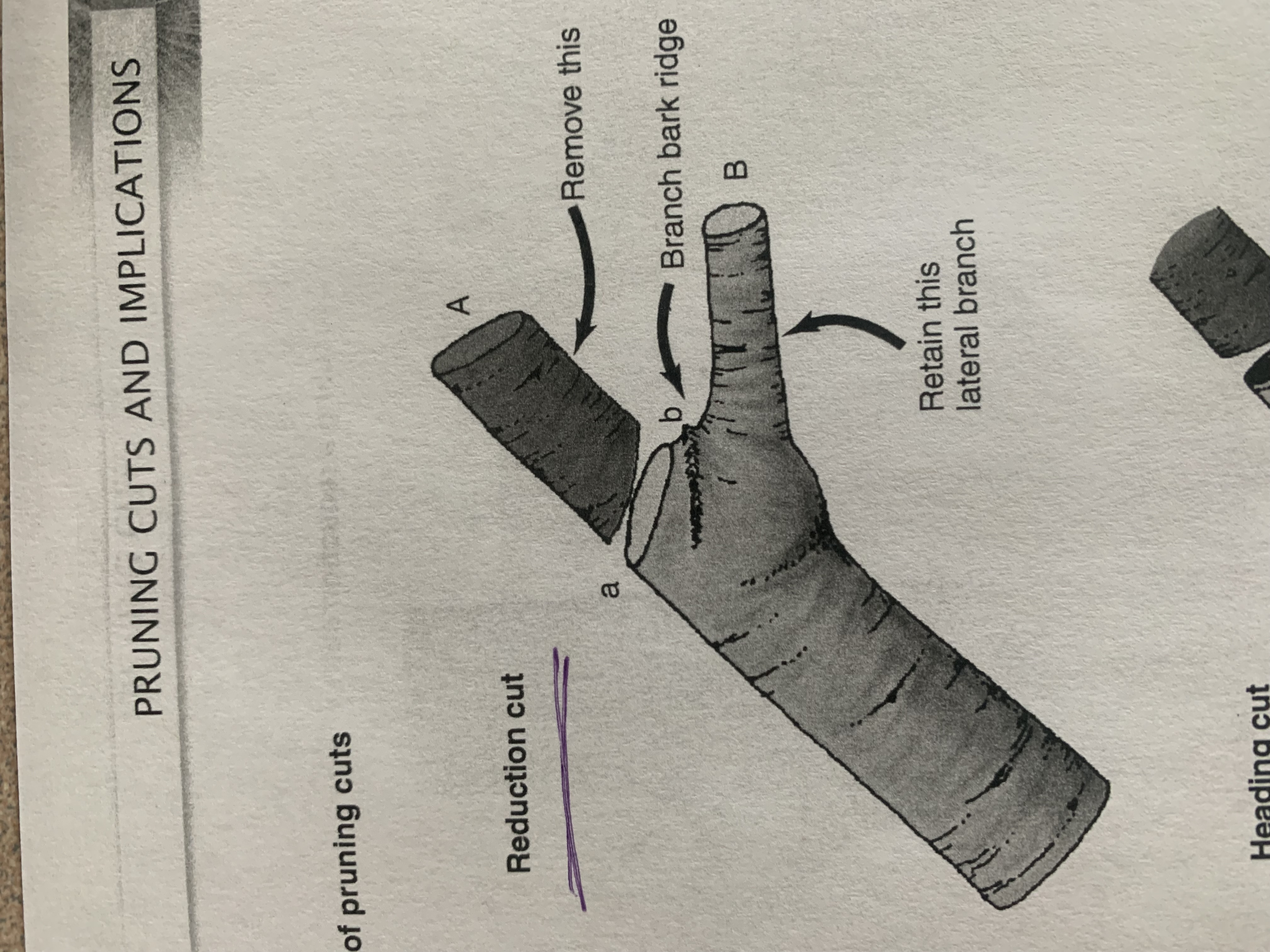Pruning REVAMPED feb 21
1/45
There's no tags or description
Looks like no tags are added yet.
Name | Mastery | Learn | Test | Matching | Spaced |
|---|
No study sessions yet.
46 Terms
What are the 3 Ds and I of pruning
Dead
Diseased
Damaged
Interfering
What are 5 reasons for pruning shrubs, vines and groundcover
1 maintain health and vigor
2 direct, control or modify growth
3 enhance flower and fruit production
4 3 Ds (dead disease and damage and interfering)
5 aesthetics
What three keys points are you promoting when “maintaining health and vigor”
plant health
Structural integrity
Light and air penetration
If you want better flower production for roses when do you prune?
In the spring before buds break dormancy
To enhance flower/fruit production in apples and pears what approximate angle of branches from the trunk is best
45-60 degrees
If a plant is constantly needing pruning due to dddi tissue issues or health and vigor what is the real problem?
Wrong plant for the space
Factors affecting the pruning of plants
Plant form
Function
Age
Location (safety or rubbing/size etc)
Timing
Pre pruning treatments
Severe pruning
Alternatives to pruning
Where is auxin found and what is it?
It is a hormone found in the growing tips of the shoots. It has a higher concentration in the buds closest to the tip of a branch. It varies a lot across species. It is about tissue differentiation and growth. And apical dominance (meaning it makes apical dominance occur)
Excurrent branching shape - is it apical dominance or control at work?
Apical control is at work. Holing that main leader and letting the laterals have just a bit of growth behind each apex. This creates a conical growth pattern (often seen in conifers)
Decurrent or deliquescent/diffuse branching what is the shape and is it apical control or dominance at work
Apical dominance but like EVERYwhere so each new shoot has dominance and a main leader is surpassed or added too creating a rounder shape (ie birches)
What is spur pruning
Shortening shoots to within a few buds of their bases. Common on fruit and berry plants to encourage lateral shoots fruit and flowering
Coppicing is
The regular heading of trees/shrubs to the ground (or drastically) to promote vigorous upright stems/ succors.
What is pollarding
Repeated heading to a permanent stubby framework to encourage lateral branch growth, Control height, Or create a similar caliper branching
Pinching is
Encouraged branching and creates more compactness depending on species. In conifers this looks like candling to maintain size. In other this is just pinching off terminal bud for heigh but also for lateral growth
What is the difference btwn the branch bark ridge and branch collar in pruning?
You cut just out from the bark ridge so the paranchyma cells dont have to go far to heal. You do NOT cut at the collar
What is the first cut you make when removing a large branch
Undercut
To reduce large regrowth in the spring you prune in
Late june early july
To reduce photosynthetic green foliage
To increase growth prune in
EARLY Spring
Secondary fall and winter (as the stores from the summer are already locked in) however if you prune in spring on plants that set buds on old wood you wont get blooms
An immediate short term, auxin effect on shoot growth and branching is called
Apical dominance
A longer-term affect of oxen on shoot and branching growth is
Apical control (The amount of growth over time)
How can you often recognize young growth
It is more stiffly upright, more vigorous with larger fleshier leaves than on mature reproductive shoots
What does severe repeated pruning do to growth?
Often it will delay, maturity of tissues and create more juvenile regrowth
What are signs in an established plant that would cause a need for replacement more than pruning?
Defective roots, caliper not balance with canopy size, Codominant leaders on a plant where that is not its normal growth pattern, sunken colors or extensive amounts of included bark
What are signs of higher exposure to sunlight?
Reduced elongation of internodes
Increased leaf thickness
Decreases in leaf size
Principal Factors that can influence the timing of pruning are?
dormancy
Flower period
Growth response
Wind and frost damage
Scorch
Additional factors that would affect the timing of pruning are?
age and type of wood
Time of year
Disease and infection
Location of plant
If a plant like hydrangeas or rhododendrons or camellia or forsythia, set their blooms for next year on THIS years growth when would you prune them?
After flowering has finished which varies for these. The spring bloomers Rhodo, Forsythia and Camellia would be end of June -July. But Hydrangea would be late feb (seeing when the foilage buds start to break. Cut back the spent heads from last year to the new buds. You can also take out about ¼ of the old shoots to help with air/shape and growth) watch for plump buds (flower not foliage) also different cultivars have different needs.
In the wisteria example in hort ed why do you prune it 2x/yr
Summer pruning the long “whips” to control form and keep air flow
Winter prune 2-3 buds from base to help with flowing next spring. Watch that you are cutting to foliage buds not flower so wait until you can tell the difference.
General recommendations for the approach to pruning are:
Know the growth habit of the plant
DDDI (Dead diseased, damaged interfering)
Cleaning refers to
Removing dead, diseased, damaged or interfering first
Thinning refers to
The vast majority of commercial landscape plant pruning
Used to maintain or reduce plant size preserve natural form, and increase light and air circulation
Often this is done on old wood
Raising pruning refers to
Removing the lower branches to provide clearance
Renovation or rejuvenation pruning is
A bigger prune to rebuild an old plant
Making cuts on half the stems one year and the remaining half the following year. It can also be used on many sub shrubs in late winter.
Plants are often headed back to within 15 to 10 cm of the ground
Hedging and pruning is
Complicated for timing, depending on the plant
Plants that sprout on old wood handle this well any time (knowing you can control growth better if you reduce photosynthetic opportunities ie foilage - for next year. IF you prune in late june early july).
Ie taxus, thuja occidentalis, carpinus (hornbeam), buxus (boxwood), euonymous, cupressus x leylandii, prunus laurocerasus (cherry laural),
FLOWERING hedges often need to be pruned AFTER flowering ie calluna vulgaris (heathe), thymus serpyllum (mother of time), santonlina chamaecyparissus (cotton lavendar) and lavandula angustofolia (english lavendar)
Group 1 plant group according to growth and flowering habits
Plants that do not regularly produce replacement growth from base
This category can include both plants that flower on current season or old wood
Prune while Young to build solid foundation
Arborescent shrubs and most trees
Group 2
Deciduous and evergreen shrubs and ground cover that produce flowers from the previous seasons wood/growth
Often require basil thinning
Removing oldest branches
Pruning after flowering
Group 3
Plants that produce flowering spurs on old wood (similar to group 2)
Commonly rosaceous trees and shrubs
Plants can be pruned to maximize flowering through dormant and growing season heading
Balance of vegetative and reproductive growth is key
Group 4
Plants that produce flowers on the current seasons growth
Some can be cut completely to the ground
Others just to the low woody framework
Pruning early to allow maximum time for flowering new development
Prune in late winter or very early spring
Includes many sub, subshrubs
Group 5
Deciduous shrubs, grown for decorative stem or foliage effect
Prune all shoots annually, hard to the ground(coppice) Or to low woody framework
Thin plants that produce multiple basil shoots
Plants must be well established before hard pruning
Pruned in mid to late winter
Group 6
Evergreen shrubs, grown primarily for foliage effect
Dormant season pruned if mild weather or pruned in spring after flowering
Vigorous evergreens may require further pruning in mid summer
Evergreens with fine leaves and stems can be shared
Mostly evergreen hedges and mass plantings
General seasonal rules are
Don’t prune when it’s wet and freezing
Don’t prune when it’s wet
Prune in early summer to control growth
Do not prune in late summer
Do not prune in spring
3types of cuts
Under cut
Reduction cut
Removal cut
Heading cut is

Removal cut is

Reduction cut is
